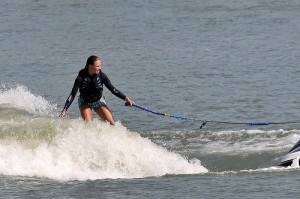Wakeboarding vs Wake Surfing: What’s The Difference?
 Wakeboarding and wake surfing are two highly popular surface water sports that focus on riding waves and boat wakes while performing various tricks. Each summer, tens of thousands of thrill-seekers from across the country hit the water to participate in these sports. The endless freedom of movement and beautiful scenery these sports offer are just a few of the many reasons why so many people participate in it.
Wakeboarding and wake surfing are two highly popular surface water sports that focus on riding waves and boat wakes while performing various tricks. Each summer, tens of thousands of thrill-seekers from across the country hit the water to participate in these sports. The endless freedom of movement and beautiful scenery these sports offer are just a few of the many reasons why so many people participate in it.
Based on their name alone, you might assume wakeboarding and wake surfing refer to the same sport. While they share some similarities, they are two different sports with their own unique characteristics.
The Board
Le’ts first talk about one of the most important elements of any surface water sport: the board. Wake surf boards are typically longer with more a surfboard-like design (hence the sport’s name). The average length of a wake surf board is 4-5 feet. Alfonso Corona was awarded with the first “wake surf board” patent in 1997, although the sport has been around since the 1950s and 60s.
Wakeboards are generally constructed with a buyout center and fiberglass coating for a superior level of performance on the water. Fins are often interchangeable, allowing the user to tailor their board to their ride style.
The Technique
The primary difference between wakeboarding and wake surfing lies in the technique. In wakeboarding, the user holds a boat-towed rope throughout the duration of the ride. This is in stark contrast to wake surfing where the user releases the rope to ride out a wake. When a wake surfer approaches a large wake, he or she will drop the line to ride the peak in a similar fashion as surfing (hence the name, wake surfing). Granted, some wake surfers will hold the rope through multiple wakes, but this reduces the rider’s speed and agility.
Boats used in wakeboarding are typically more complex, featuring large “wake towers” made of stainless steel and aluminum piping. The purpose of these towers is to raise the rope’s pull point 6-7 feet higher than the surface of the water. This allows for greater maneuverability when performing in-air tricks. Ski boats and even jet skis are often used to tow wake surfers. People who are serious about the sport of wake surfing weigh their boats down with cinder blocks, water, metal and other heavy objects to create larger wakes. These larger wakes promote bigger, more exciting jumps for the rider. Wakesurfing requires an inboard boat where the propeller is under the boat. For obvious reason being so close to the back of the boat/propeller the typical sterndrive is not safe for surfing whereas it is for wakeboarding. Wakesurfing requires an inboard boat where the propeller is under the boat. For obvious reason being so close to the back of the boat/propeller the typical sterndrive is not safe for surfing whereas it is for wakeboarding.
Wakesurfing is becoming the sport of choice not only for the younger crowd but also the 40+ age group. We sold a Tige wakeboard/surf boat a couple of years ago to a customer that shot a video of them making a peanut butter sandwich while surfing. It offers the luxury of allowing the rider to be as laid back or aggressive as they choose. I guess it depends on your personal preference.
So, which surface water sport is the best? Wakeboarding and wake surfing are two exhilarating sports with their own unique advantages and disadvantages that people of all ages and backgrounds can enjoy. I recommend trying them both to determine which one is right for you.
